The Dielectric Behavior of Protected HKUST-1
Abstract
:1. Introduction
2. Materials and Methods
2.1. Synthesis
2.2. MOF Surface Protection
2.3. Dielectric Constant Measurement
2.4. X-ray Diffraction
2.5. Water Absorption Isotherms
2.6. Theoretical Calculations
3. Results and Discussion
3.1. HKUST-1 under Electric Field
3.2. Dielectric Behaviour of Protected HKUST-1
3.3. Correlation between Isotherm Adsorption Curves and Dielectric Constant
4. Conclusions
- HKUST-1 is known to be a highly porous and hydrophilic material, and our experiments demonstrated that it is also stable in an electric field. In fact, no significant distortion of the framework was observed upon application of an external voltage. From another perspective, although the water guest molecules in the pores and channels do indeed react to the application of a field, they do not order significantly, to become more observable than in the absence of a field.
- The diffraction experiments on HKUST-1 after changing the guest from water to CH2Br2 revealed the differences between the two topological classes of pores: the tetrahedral (smaller) cavities trap CH2Br2, whereas the octahedral (larger) cavities cannot block them. This obviously implies that smaller guest molecules also experience different types of interactions with the framework, depending on the pores they enter. In these experiments, only binding to the framework was distinguishable (at Cu(II) sites, at the carboxylic groups of the linkers, or without any direct interaction with the framework).
- The tested amine surface reaction significantly improved the transformation of HKUST-1 (or in principle other MOFs) into a truly hydrophobic material, while maintaining its crystallinity. The main proofs of this statement are: (a) the reduced adsorption of water in the bulk, as proved by gravimetric and adsorption isotherm experiments; (b) the small values and the significant stability of the dielectric constant along the range of the scanned frequencies; and (c) the stability over time of the low dielectric conditions. The last point, however, requires further testing and probably also optimization of the fabrication techniques.
- The comparison between vapor adsorption isotherms and dielectric constant measurements indicated that a new perspective can be adopted when investigating the adsorption properties of MOFs. The measurement of the dielectric constant was quite rapid (although requiring a significant amount of material) and provided a response that agreed with the traditionally adopted adsorption isotherms. In particular, the protected MOFs (except for 1-NTA) revealed a single-stage mechanism, which is evident from the fact that κ (1 Hz) was quite similar to κ (1 MHz), growing linearly with time, rather than exponentially.
- Although in this study we explored only a limited number of amines, it seems evident that an alkyl chain improves the performance of the amine. Indeed, although 3P1PA (the most efficient) can be classified as an aromatic amine, it possesses a medium-length chain separating the aromatic ring from the amino group. On the other hand, amino groups directly linked to the aromatic ring do not seem to be so efficient. This is especially true for 1NTA (featuring a hindered aromatic system). Probably the combination of an aromatic ring and an alkyl chain is the best solution, because it combines the anchoring ability to the framework binding sites typical of flexible alkylic chains and the inherent hydrophobicity of aromatic rings.
Supplementary Materials
Author Contributions
Funding
Institutional Review Board Statement
Informed Consent Statement
Data Availability Statement
Acknowledgments
Conflicts of Interest
References
- Hideshi, M.; Kenji, I.; Makoto, S.; Masaru, H. Review of methods for the mitigation of plasma-induced damage to low-dielectric-constant interlayer dielectrics used for semiconductor logic device interconnects. Plasma Process. Polym. 2019, 16, e1900039. [Google Scholar] [CrossRef]
- Usman, M.; Lu, K.L. Metal-organic frameworks: The future of low-κ materials. NPG Asia Mater. 2016, 8, e333. [Google Scholar] [CrossRef]
- Eddaoudi, M.; Moler, D.B.; Li, H.; Chen, B.; Reineke, T.M.; O’Keeffe, M.; Yaghi, O.M. Modular chemistry: Secondary building units as a basis for the design of highly porous and robust Metal-Organic Carboxylate Frameworks. Acc. Chem. Res. 2001, 34, 319–330. [Google Scholar] [CrossRef] [PubMed]
- Chen, Z.; Kirlikovali, O.K.; Li, P.; Farha, O.K. Reticular chemistry for highly porous Metal-Organic frameworks: The chemistry and applications. Acc. Chem. Res. 2022, 55, 579–591. [Google Scholar] [CrossRef] [PubMed]
- Howarth, A.J.; Liu, Y.; Li, P.; Li, Z.; Wang, T.C.; Hupp, J.T.; Farha, O.K. Chemical, thermal and mechanical stabilities of metal-organic frameworks. Nat. Rev. Mater. 2016, 1, 15018. [Google Scholar] [CrossRef]
- Kim, H.; Rao, S.R.; Kapustin, E.A.; Zhao, L.; Yang, S.; Yaghi, O.M.; Wang, E.N. Adsorption-based atmospheric water harvesting device for arid climates. Nat. Comm. 2018, 9, 1191. [Google Scholar] [CrossRef] [PubMed] [Green Version]
- Babal, A.S.; Chaudhari, A.K.; Yeung, H.H.-M.; Tan, J.-C. Guest-tunable dielectric sensing using a single crystal of HKUST-1. Adv. Mater. Interfaces 2020, 7, 2000408. [Google Scholar] [CrossRef]
- Zhang, W.; Hu, Y.; Ge, J.; Jiang, H.L.; Yu, S.H. A Facile and general coating approach to moisture/water-resistant Metal–Organic frameworks with intact porosity. J. Am. Chem. Soc. 2014, 136, 16978–16981. [Google Scholar] [CrossRef]
- Gao, M.L.; Zhao, S.Y.; Chen, Z.Y.; Liu, L.; Han, Z.B. Superhydrophobic/Superoleophilic MOF Composites for Oil–Water Separation. Inorg. Chem. 2019, 58, 2261–2264. [Google Scholar] [CrossRef] [PubMed]
- Chui, S.S.-Y.; Lo, S.M.-F.; Charmant, J.P.H.; Orpen, A.G.; Williams, I.D. Chemically Functionalizable Nanoporous Material [Cu3(TMA)2(H2O)3]n. Science 1999, 283, 1148–1150. [Google Scholar] [CrossRef]
- Todaro, M.; Buscarino, G.; Sciortino, L.; Alessi, A.; Messina, F.; Taddei, M.; Ranocchiari, M.; Cannas, M.; Gelardi, F.M. Decomposition process of carboxylate MOF HKUST-1 unveiled at the atomic scale level. J. Phys. Chem. C. 2016, 120, 12879–12889. [Google Scholar] [CrossRef] [Green Version]
- Xue, W.; Zhang, Z.; Huang, H.; Zhong, C.; Mei, D. Theoretical insights into the initial hydrolytic breakdown of HKUST-1. J. Phys. Chem. C. 2020, 124, 1991–2001. [Google Scholar] [CrossRef]
- McHugh, L.N.; McPherson, M.J.; McCormick, L.J.; Morris, S.A.; Wheatley, P.S.; Teat, S.J.; McKay, D.; Dawson, D.M.; Sansome, C.E.F.; Ashbrook, S.E.; et al. Hydrolytic stability in hemilabile metal-organic frameworks. Nat. Chem. 2018, 10, 1096–1102. [Google Scholar] [CrossRef] [PubMed] [Green Version]
- Ghoufi, A.; Benhamed, K.; Boukli-Hacene, L.; Maurin, G. Electrically Induced Breathing of the MIL-53(Cr) Metal-organic Framework. ACS Cent. Sci. 2017, 3, 394–398. [Google Scholar] [CrossRef] [PubMed]
- Wu, Y.; Kobayashi, A.; Halder, G.J.; Peterson, V.K.; Chapman, K.W.; Lock, N.; Southon, P.D.; Kepert, C.J. Negative thermal expansion in the metal-organic framework material Cu3(1,3,5-benzenetricarboxylate)2. Angew. Chem. Int. Ed. 2008, 47, 8929–8932. [Google Scholar] [CrossRef]
- Schlichte, K.; Kratzke, T.; Kaskel, S. Improved synthesis, Thermal Stability and Catalytic Properties of The Metal-Organic Framework Compound Cu3(BTC)2. Microporous Mesoporous Mater. 2004, 73, 81–88. [Google Scholar] [CrossRef]
- Willmott, P.R.; Meister, D.; Leake, S.J.; Lange, M.; Bergamaschi, A.; Boge, M.; Calvi, M.; Cancellieri, C.; Casati, N.; Cervellino, A.; et al. The Materials Science beamline upgrade at the Swiss Light Source. J. Synchrotron Rad. 2013, 20, 667–682. [Google Scholar] [CrossRef]
- Rigaku Oxford Diffraction. CrysAlisPro Software System, Version 171.41.93a; Rigaku Corporation: Oxford, UK, 2021. [Google Scholar]
- Dolomanov, O.V.; Bourhis, L.J.; Gildea, R.J.; Howard, J.A.K.; Puschmann, H. OLEX2: A complete structure solution, refinement and analysis program. J. Appl. Cryst. 2009, 42, 229–341. [Google Scholar] [CrossRef]
- Macrae, C.F.; Sovago, I.; Cottrell, S.J.; Galek, P.T.A.; McCabe, P.; Pidcock, E.; Platings, M.; Shields, G.P.; Stevens, J.S.; Towler, M.; et al. Mercury 4.0: From visualization to analysis, design and prediction. J. Appl. Cryst. 2020, 53, 226–235. [Google Scholar] [CrossRef] [PubMed] [Green Version]
- Becke, A.D.J. Density-functional thermochemistry. III. The role of exact exchange. Chem. Phys. 1993, 98, 5648–5652. [Google Scholar] [CrossRef] [Green Version]
- Lee, C.; Yang, W.; Parr, R.G. Development of the Colle-Salvetti correlation-energy formula into a functional of the electron density. Phys. Rev. B 1988, 37, 785–789. [Google Scholar] [CrossRef] [Green Version]
- Weigend, F.; Ahlrichs, R. Balanced basis sets of split valence, triple zeta valence and quadruple zeta valence quality for H to Rn: Design and assessment of accuracy. Phys. Chem. Chem. Phys. 2005, 7, 3297–3305. [Google Scholar] [CrossRef] [PubMed]
- Weigend, F. Accurate Coulomb-fitting basis sets for H to Rn. Phys. Chem. Chem. Phys. 2006, 8, 1057–1065. [Google Scholar] [CrossRef] [PubMed]
- Frisch, M.J.; Trucks, G.W.; Schlegel, H.B.; Scuseria, G.E.; Robb, M.A.; Cheeseman, J.R.; Scalmani, G.; Barone, V.; Petersson, G.A.; Nakatsuji, H.; et al. Gaussian 16, Revision C.01; Gaussian, Inc.: Wallingford, CT, USA, 2016. [Google Scholar]
- Krawczuk, A.; Pérez, D.; Macchi, P.J. PolaBer: A program to calculate and visualize distributed atomic polarizabilities based on electron density partitioning. Appl. Cryst. 2014, 47, 1452–1458. [Google Scholar] [CrossRef] [Green Version]
- Bader, R.F.W. Atoms in Molecules: A Quantum Theory; Oxford University Press: New York, NY, USA, 1990. [Google Scholar]
- Keith, T.A. AIMAll. Version 19.10.12; TK Gristmill Software: Overland Park, KS, USA, 2019. [Google Scholar]
- Bader, R.; Keith, T.; Gough, K.; Laidig, K. Properties of atoms in molecules: Additivity and transferability of group polarizabilities. Mol. Phys. 1992, 75, 1167–1189. [Google Scholar] [CrossRef]
- Nye, J.F. Physical Properties of Crystals: Their Representation by Tensors and Matrices; Oxford University Press: Oxford, UK, 1957. [Google Scholar]
- Scatena, R.; Guntern, Y.T.; Macchi, P. Electron density and dielectric properties of highly porous MOFs: Binding and mobility of guest molecules in Cu3(BTC)2 and Zn3(BTC)2. J. Am. Chem. Soc. 2019, 141, 9382–9390. [Google Scholar] [CrossRef] [PubMed] [Green Version]
- Kitagawa, S.; Kitaura, R.; Noro, S.-I. Functional Porous Coordination Polymers. Angew. Chem. Int. Ed. 2004, 43, 2334–2375. [Google Scholar] [CrossRef] [PubMed]
- Talin, A.A.; Centrone, A.; Ford, A.C.; Foster, M.E.; Stavila, V.; Haney, P.; Kinney, R.A.; Szalai, V.; Gabaly, F.E.; Yoon, H.P.; et al. Tunable electrical conductivity in metal-organic framework thin-film devices. Science 2014, 343, 66–69. [Google Scholar] [CrossRef]
- Canivet, J.; Fateeva, A.; Guo, Y.; Coasne, B.; Farrusseng, D. Water adsorption in MOFs: Fundamentals and applications. Chem. Soc. Rev. 2014, 43, 5594–5617. [Google Scholar] [CrossRef] [Green Version]
- Álvarez, J.R.; Sánchez-González, E.; Pérez, E.; Schneider-Revueltas, E.; Martínez, A.; Tejeda-Cruz, A.; Islas-Jácome, A.; González-Zamora, E.; Ibarra, I.A. Structure stability of HKUST-1 towards water and ethanol and their effect on its CO2 capture properties. Dalton Trans. 2017, 46, 9192–9200. [Google Scholar] [CrossRef] [PubMed]
- Küsgens, P.; Rose, M.; Senkovska, I.; Fröde, H.; Henschel, A.; Siegle, S.; Kaskel, S. Characterization of metal-organic frameworks by water adsorption. Microporous Mesoporous Mater. 2009, 120, 325–330. [Google Scholar] [CrossRef]
- Janiak, C.; Henninger, S.K. Porous coordination polymers as novel sorption materials for heat transformation processes. Chim. Int. J. Chem. 2013, 67, 419–424. [Google Scholar] [CrossRef] [PubMed] [Green Version]
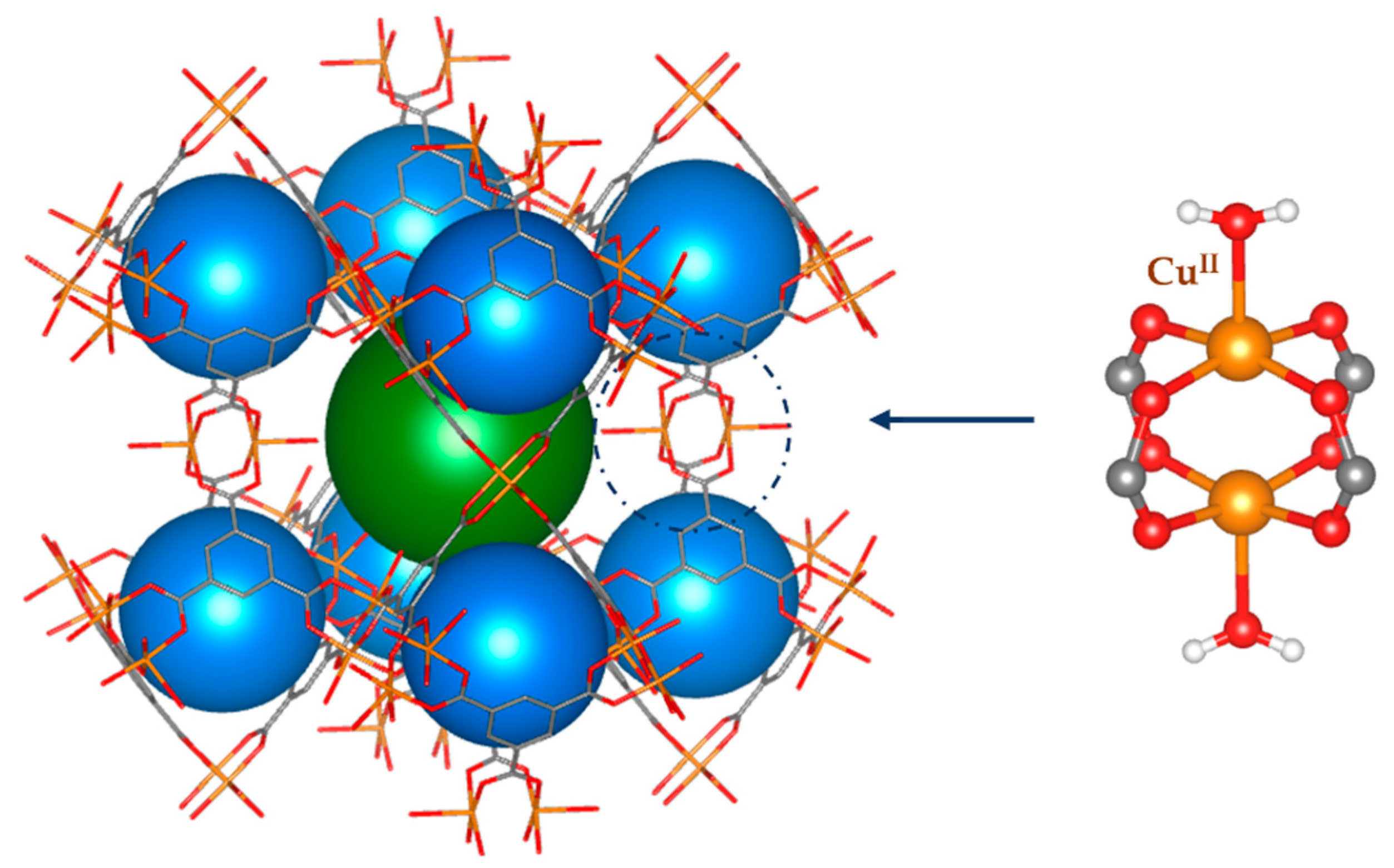
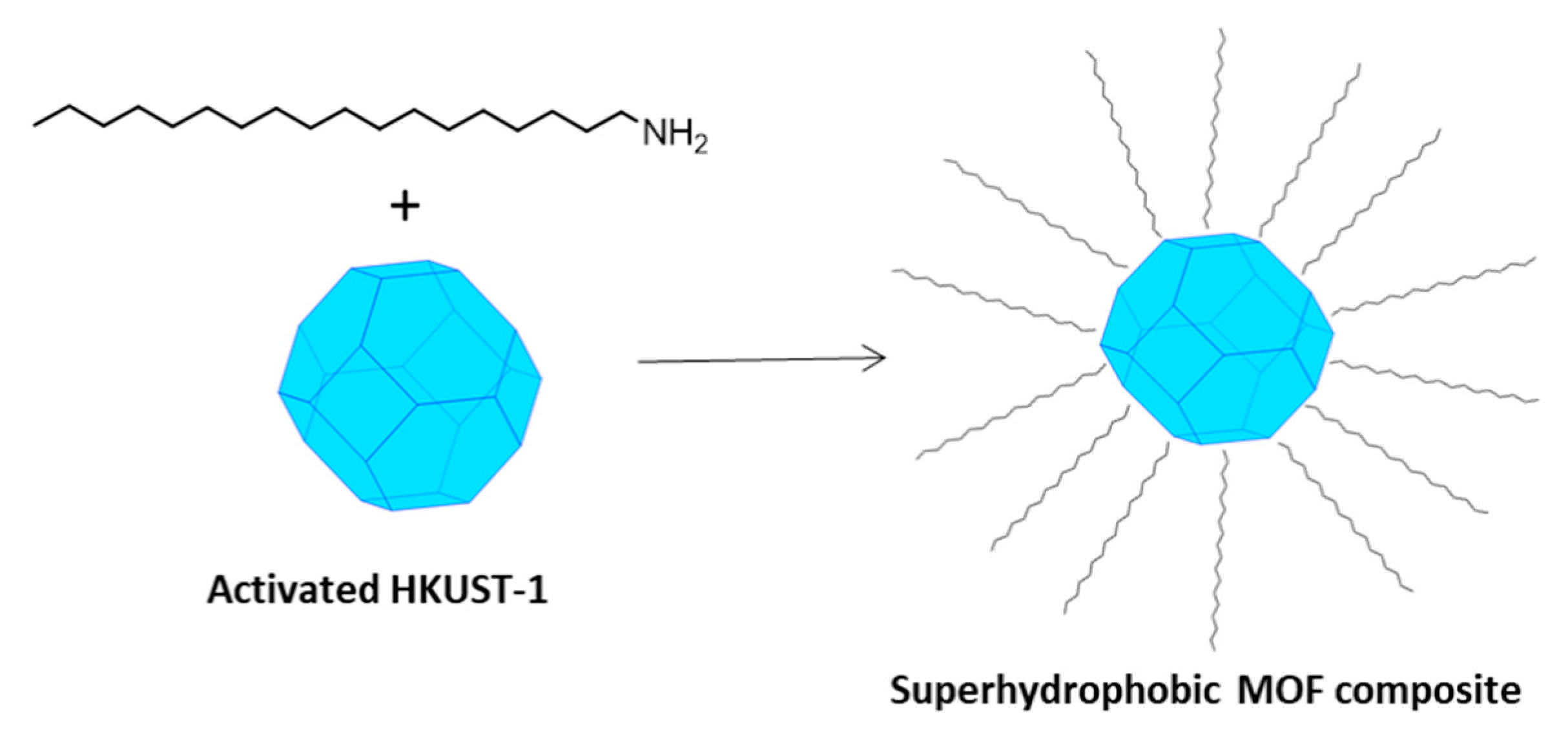

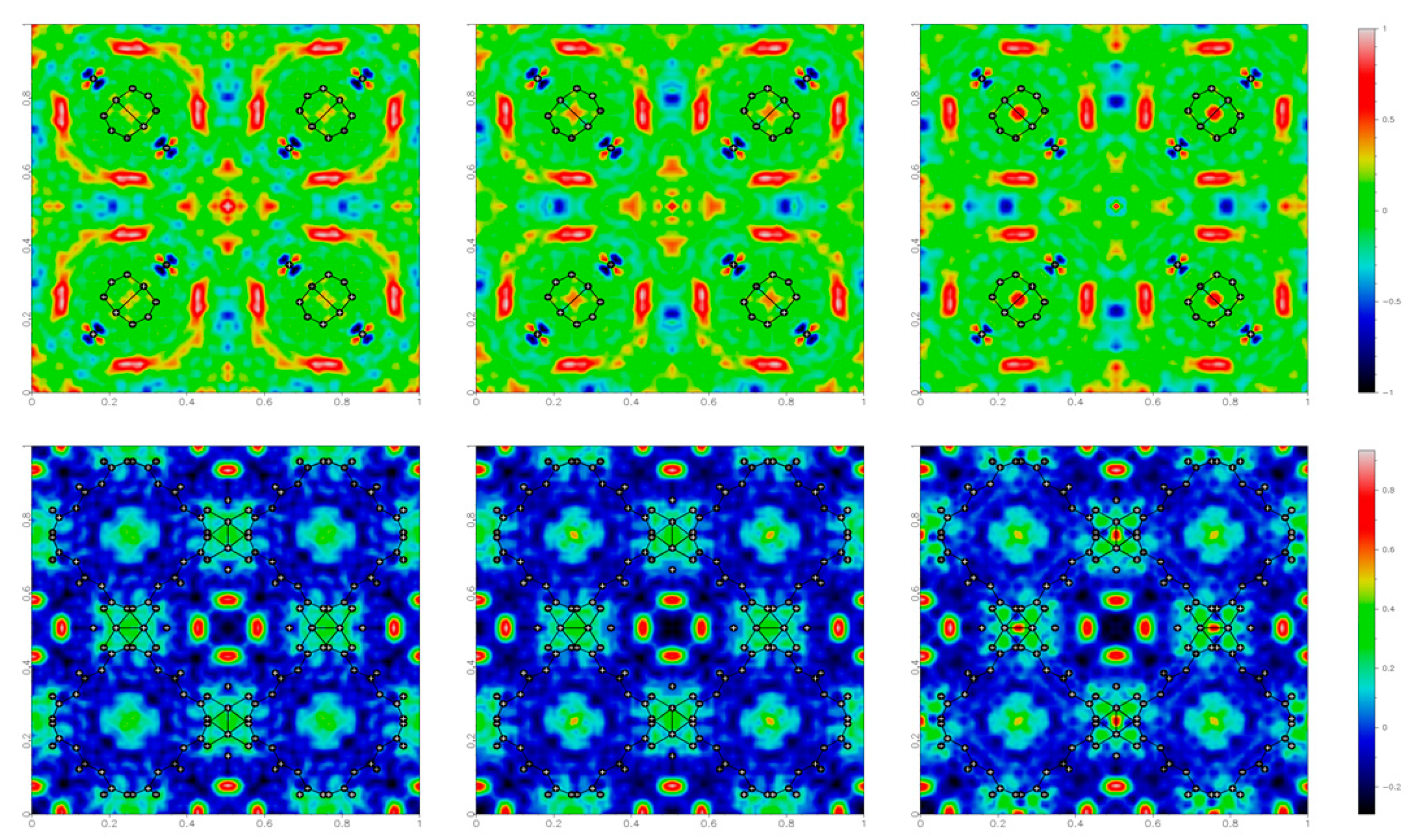
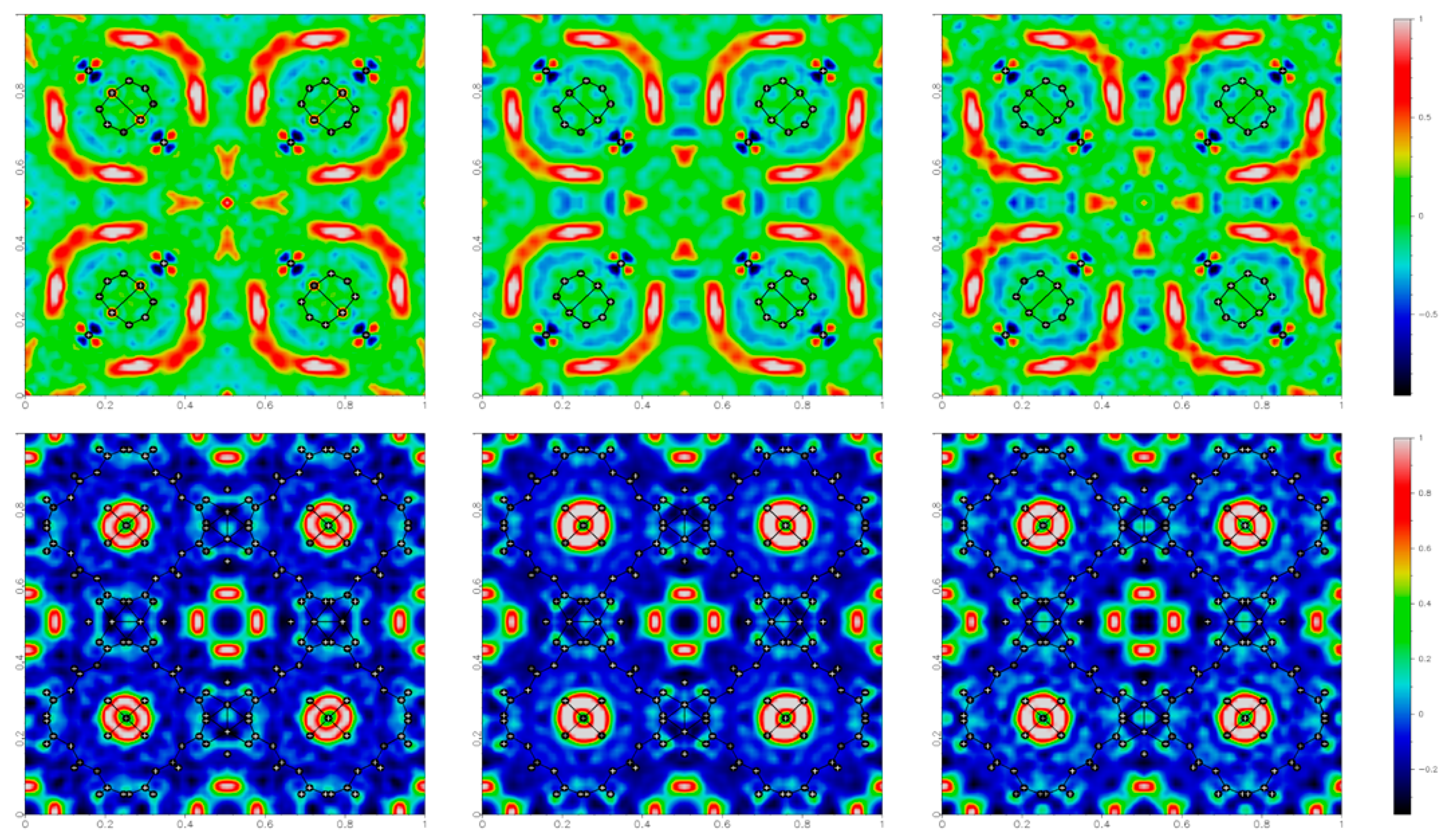
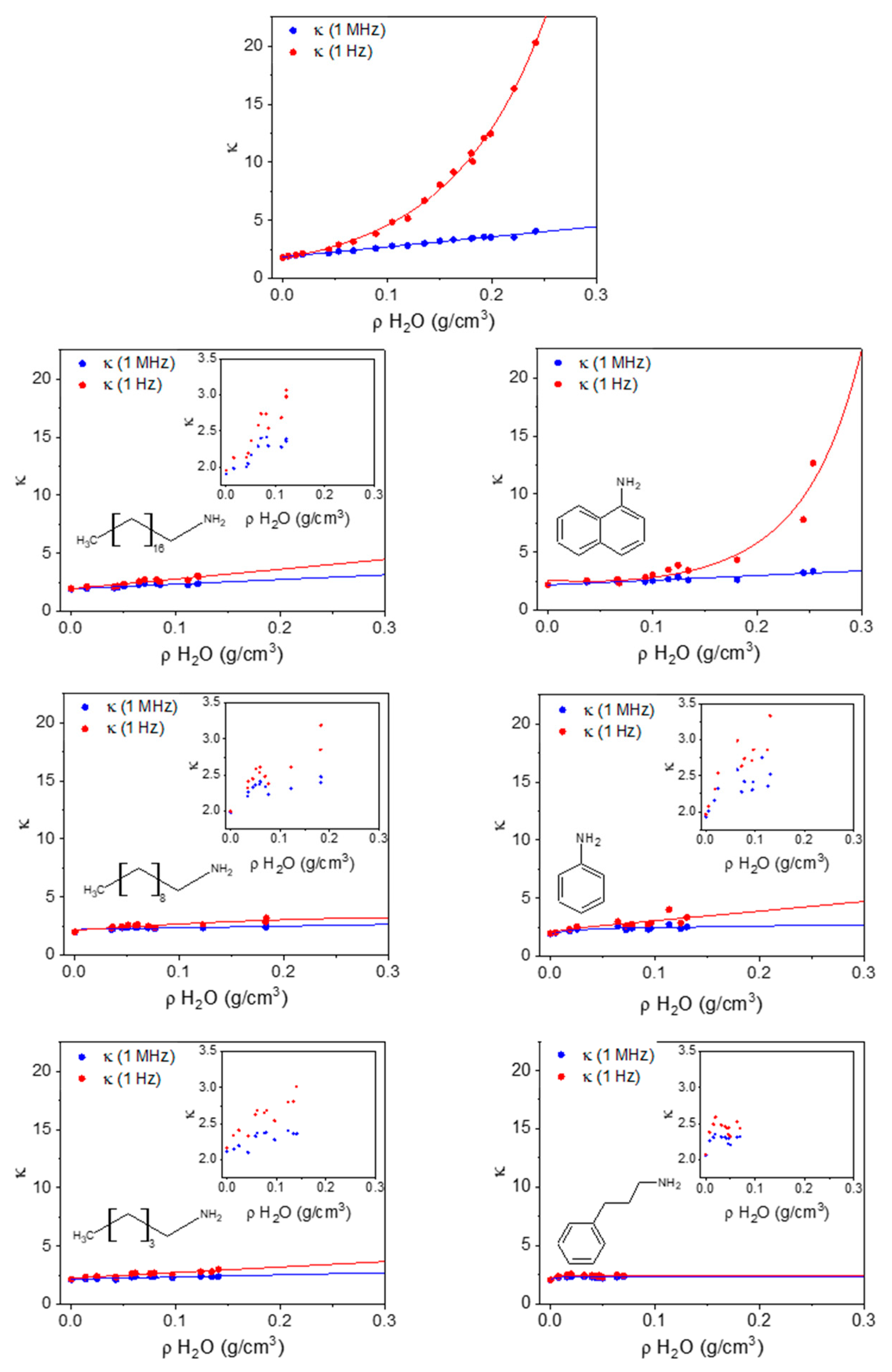
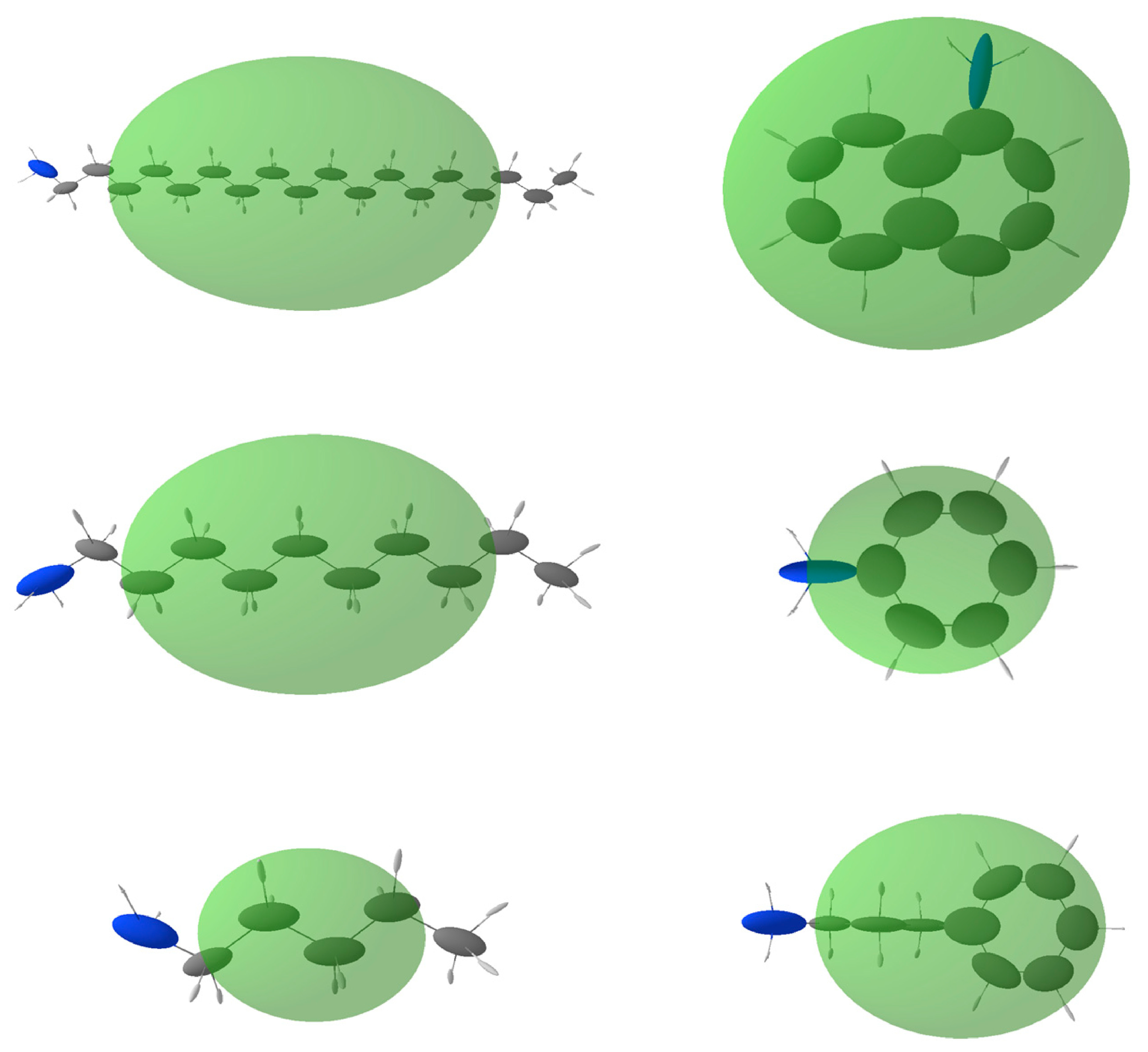
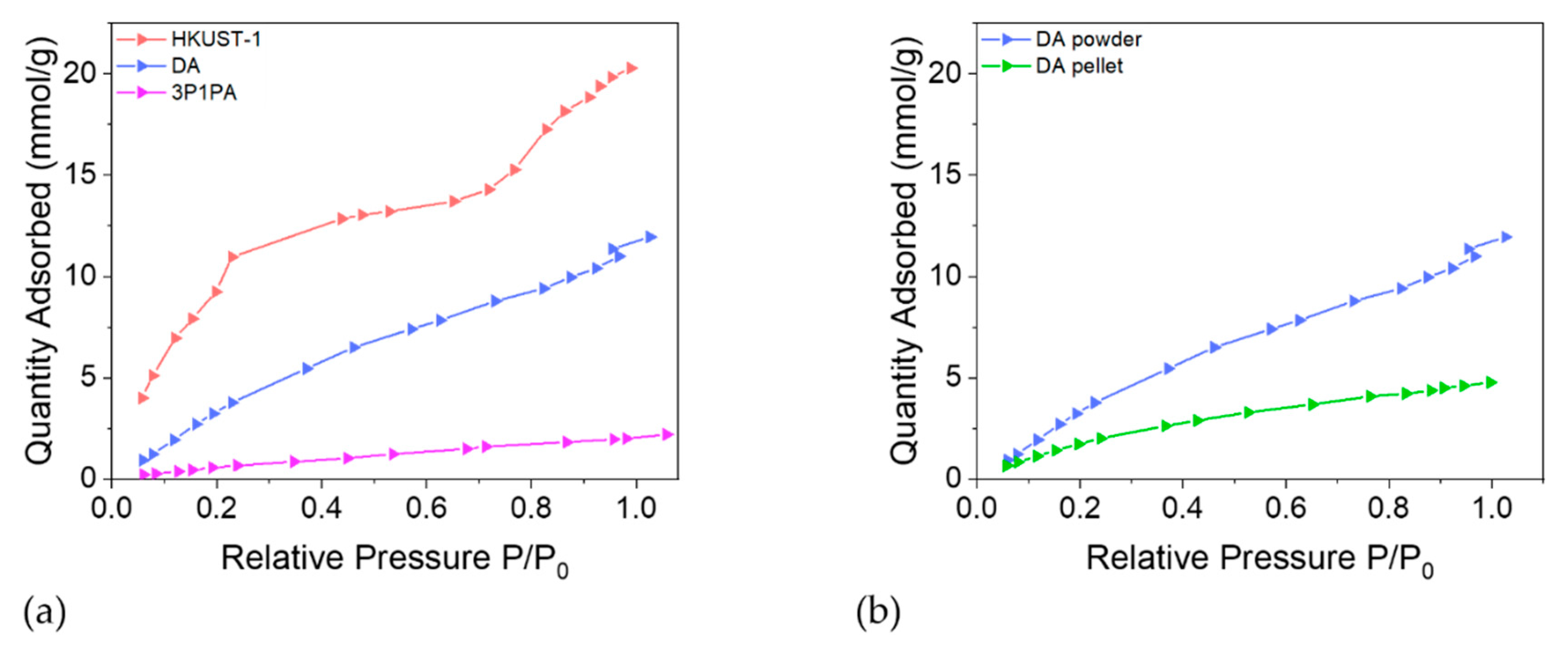
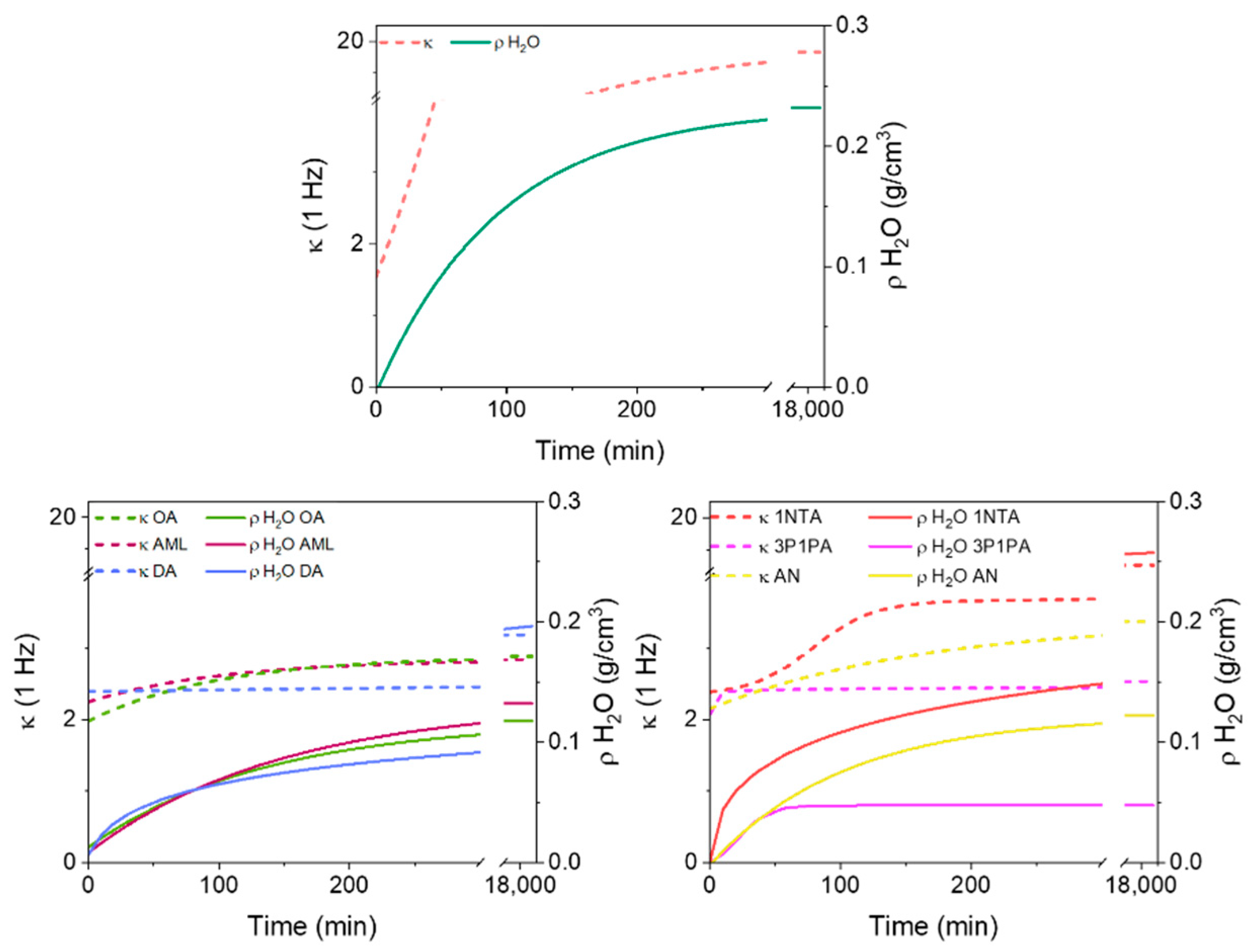
| RNH2 | Acronym | Amount of RNH2 (g) | Amount of HKUST-1 (g) | Composite Color |
|---|---|---|---|---|
| Octadecylamine | OA | 1.348 | 1.000 | Dark Blue |
| Decylamine | DA | 0.786 | 1.000 | Dark Blue |
| Amylamine | AM | 0.435 | 1.000 | Dark Blue |
| 1-Naphthylamine | 1NTA | 0.716 | 1.000 | Black |
| Aniline | AN | 0.465 | 1.000 | Dark Green |
| 3-Phenyl-1-propylamine | 3P1PA | 0.676 | 1.000 | Dark Blue |
| Protecting Amine | αISO (Bohr3) | Theor. Δκ | Expt. Δκ (1 MHz) |
|---|---|---|---|
| Octadecylamine | 234.7 | 1.15 | 0.11 |
| Decylamine | 133.9 | 0.65 | 0.18 |
| Amylamine | 71.7 | 0.35 | 0.32 |
| 1-Naphthylamine | 125.6 | 0.61 | 0.39 |
| Aniline | 75.9 | 0.37 | 0.24 |
| 3-Phenyl-1-propylamine | 112.8 | 0.55 | 0.27 |
Publisher’s Note: MDPI stays neutral with regard to jurisdictional claims in published maps and institutional affiliations. |
© 2022 by the authors. Licensee MDPI, Basel, Switzerland. This article is an open access article distributed under the terms and conditions of the Creative Commons Attribution (CC BY) license (https://creativecommons.org/licenses/by/4.0/).
Share and Cite
Sorbara, S.; Casati, N.; Colombo, V.; Bossola, F.; Macchi, P. The Dielectric Behavior of Protected HKUST-1. Chemistry 2022, 4, 576-591. https://doi.org/10.3390/chemistry4020041
Sorbara S, Casati N, Colombo V, Bossola F, Macchi P. The Dielectric Behavior of Protected HKUST-1. Chemistry. 2022; 4(2):576-591. https://doi.org/10.3390/chemistry4020041
Chicago/Turabian StyleSorbara, Simona, Nicola Casati, Valentina Colombo, Filippo Bossola, and Piero Macchi. 2022. "The Dielectric Behavior of Protected HKUST-1" Chemistry 4, no. 2: 576-591. https://doi.org/10.3390/chemistry4020041
APA StyleSorbara, S., Casati, N., Colombo, V., Bossola, F., & Macchi, P. (2022). The Dielectric Behavior of Protected HKUST-1. Chemistry, 4(2), 576-591. https://doi.org/10.3390/chemistry4020041







